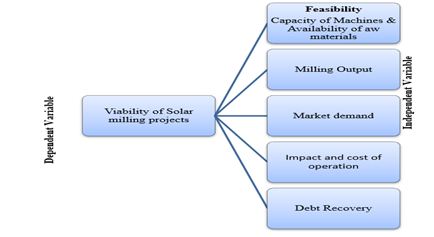A Study of the Viability of Zambia Co-Operative Federation (ZCF) Installed Solar Milling Plants in Zambia
DOI:
https://doi.org/10.5281/zenodo.10775289Keywords:
zcf, viability, co-operative, solar milling plantAbstract
This portfolio thesis is aimed at critically evaluating the viabilities of the Solar milling plants and thought process of cooperatives in rural areas on repaying back of loans using pragmatic action research. This thesis contributes to the empirically and theoretically based understanding of, the impact of the presidential funds in Zambia. A case study of Solar Milling plants across Zambia via ZCF. This study was a participatory in nature, hence, a cross sectional approach was undertaken in the first half of 2016, 2017 and part of 2018 to access primary, district and provincial corporative responses regarding viability of the solar milling plants in the community and to ZCF. In the results, several findings were established which tried to satisfy the objectives of the study. The correlation model revealed that there was a significant difference in between monthly target and monthly recovery fund. A weak relationship was found between the two variables that indicate differences exist between the two groups. This implies that a The viability of solar milling plant and loan recovery is low and not very feasible. This result was found to be significant with p values less than 0.05 and the entire model was significant at p-values (0.0387<0.05). Regarding the factors related to Zambia Co-operative Federation (ZCF) Debt recovery on the installed solar milling plants in Zambia were revealed to repayment history, capacity of machine, Binding cooperative contract, raw material and system of recovery, OR=0.8494, p=0.001. It was also found that despite minor difference these factors were established to directly related to debt rectory. Recommendations have been made to ZCF management to also provide resources for the cooperatives who are managing the milling plants with startup capital to buy maize and packaging materials for the mealie meal and also provide tools for recovery officers to use when following up loan payments from cooperatives. The need to train cooperators on corporate governance, book keeping so that there is comprehensive general accountability.
Downloads
References
Adeyemo, R. (1984). Loan delinquency in multi-purpose cooperative Union in Kawara state.
Alton R.G, & Hazen J.H. (2001). As economy flounders, Do we see a rise in problem loans?. Federal Reserve Bank of St Louis. 23.
Bekele, T. (1995). Rural credit in Ethiopia. Ethiopian Agricultural Problems of Transformation Proceedings of the Fourth Annual Conference on the Ethiopian Economy. Addis Ababa, Ethiopia.
Chigumira, G. (2019). Assessment of demand in agro-processing machinery in the SADC region: A case study of the maize-milling machinery value chain in South Africa and Zambia. WIDER Working Paper Series Wp-2019-70. World Institute for Development Economics Research (UNU-WIDER).
Duqm, S. (2022). Techno-economic feasibility of a solar-wind-fuel cell energy system in Duqm, Oman.
Guno, C.S., & Agaton, C.B. (2022). Socio-economic and environmental analyses of solar irrigation systems for sustainability socio-economic and environmental analyses of solar irrigation systems for sustainable agricultural production. Available at: https://doi.org/10.3390/su14116834.
Formisano. V, Quattrociocchi, B., & Fedele, M. (2018). From viability to sustainability : The 7. contribution of the viable systems approach (VSA), pp. 1–17. Available at: https://doi.org/10.3390/su10030725.
Goldberg, L.G., & White, L.J. (2004). Cookie-cutter versus character: The micro structure of small business lending by large and small banks. Journal of Financial and Quantitative Analysis, 39, 227-251.
Lipton, M. (1996). Demystifying the development of an organizational vision. Loan Management Review, 37(4), 83-91.
Maliro, P., Diarra, B., & Samikannu, R. (2022). Technical and economic feasibility assessment for a solar PV mini-grid for Matekenya village Technical and economic feasibility assessment for a solar PV mini-grid for Matekenya village. Cogent Engineering, 9(1). Available at: https://doi.org/10.1080/23311916.2022.2110707.
Munyenyembe, H. (2015). Economic assessment of solar milling plants as an investment tool : A case of katete district-Zambia. Available at: https://doi.org/10.21522/TIJMG.2015.07.02.Art009.
Saint-pierre, P. (2011). Viability theory : New directions viability theory. Available at: https://doi.org/10.1007/978-3-642-16684-6.
McCann. F, & McIndoe-Calder.T. (2012). Determinants of SME loan default: The importance of borrower-level heterogeneity.
Nkole. E. (1993). Access and opportunities: The need for support among small and micro scale entrepreneurs in Zambia, Lusaka.
Nkusu, M. (2011). Nonperforming loans and macro financial vulnerabilities in advanced economies.
Rajiv, & Sarat C. Dhal. (2003). Non-performing loans and terms of credit of public sector banks in India.
Sanchis-Arellano, A. (2006). Household debt sustainability: What explains household non-performing loans? An empirical analysis. ECB Working Paper. 49.
Schwaninger, M. (2018). Theories of viability : A comparison. Available at: https://doi.org/10.1002/sres.731.
Singh, S. et al. (2022). Performance evaluation and financial viability analysis of grid associated 10 M W P solar photovoltaic power plant at UP India. Scientific Reports,
Ssegawa, J.K., & Muzinda, M. (2021). ScienceDirect feasibility assessment framework (FAF): A systematic and feasibility assessment framework a systematic and objective approach for assessing the viability of a project objective approach for assessing the viability of a project. Procedia Computer Science, 181(2019), 377–385. Available at: https://doi.org/10.1016/j.procs.2021.01.180.
Tadesse, G. (2011). Feasibility stu study of small hydro / pv / win ind hybrid system for or off-grid rural electrifica ication in’, (May).

Downloads
Published
How to Cite
Issue
Section
License
Copyright (c) 2024 George Nkandu

This work is licensed under a Creative Commons Attribution 4.0 International License.
Research Articles in 'Management Journal for Advanced Research' are Open Access articles published under the Creative Commons CC BY License Creative Commons Attribution 4.0 International License http://creativecommons.org/licenses/by/4.0/. This license allows you to share – copy and redistribute the material in any medium or format. Adapt – remix, transform, and build upon the material for any purpose, even commercially.









